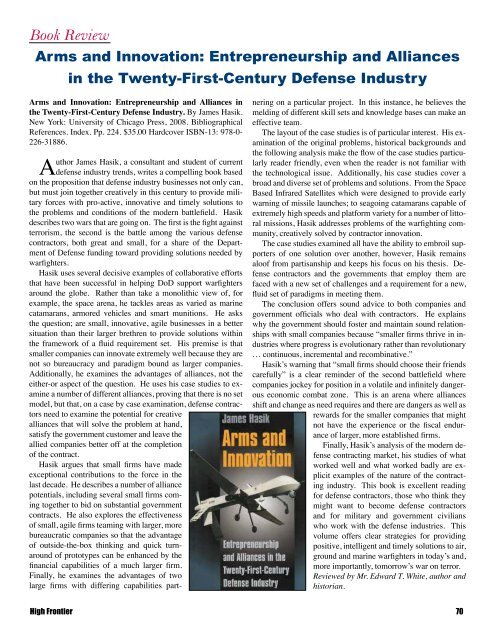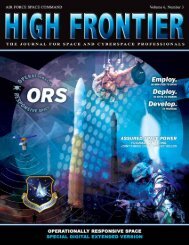Space Acquisition - Air Force Space Command
Space Acquisition - Air Force Space Command
Space Acquisition - Air Force Space Command
Create successful ePaper yourself
Turn your PDF publications into a flip-book with our unique Google optimized e-Paper software.
Book Review<br />
Arms and Innovation: Entrepreneurship and Alliances<br />
in the Twenty-First-Century Defense Industry<br />
Arms and Innovation: Entrepreneurship and Alliances in<br />
the Twenty-First-Century Defense Industry. By James Hasik.<br />
New York: University of Chicago Press, 2008. Bibliographical<br />
References. Index. Pp. 224. $35.00 Hardcover ISBN-13: 978-0-<br />
226-31886.<br />
Author James Hasik, a consultant and student of current<br />
defense industry trends, writes a compelling book based<br />
on the proposition that defense industry businesses not only can,<br />
but must join together creatively in this century to provide military<br />
forces with pro-active, innovative and timely solutions to<br />
the problems and conditions of the modern battlefield. Hasik<br />
describes two wars that are going on. The first is the fight against<br />
terrorism, the second is the battle among the various defense<br />
contractors, both great and small, for a share of the Department<br />
of Defense funding toward providing solutions needed by<br />
warfighters.<br />
Hasik uses several decisive examples of collaborative efforts<br />
that have been successful in helping DoD support warfighters<br />
around the globe. Rather than take a monolithic view of, for<br />
example, the space arena, he tackles areas as varied as marine<br />
catamarans, armored vehicles and smart munitions. He asks<br />
the question; are small, innovative, agile businesses in a better<br />
situation than their larger brethren to provide solutions within<br />
the framework of a fluid requirement set. His premise is that<br />
smaller companies can innovate extremely well because they are<br />
not so bureaucracy and paradigm bound as larger companies.<br />
Additionally, he examines the advantages of alliances, not the<br />
either-or aspect of the question. He uses his case studies to examine<br />
a number of different alliances, proving that there is no set<br />
model, but that, on a case by case examination, defense contractors<br />
need to examine the potential for creative<br />
alliances that will solve the problem at hand,<br />
satisfy the government customer and leave the<br />
allied companies better off at the completion<br />
of the contract.<br />
Hasik argues that small firms have made<br />
exceptional contributions to the force in the<br />
last decade. He describes a number of alliance<br />
potentials, including several small firms coming<br />
together to bid on substantial government<br />
contracts. He also explores the effectiveness<br />
of small, agile firms teaming with larger, more<br />
bureaucratic companies so that the advantage<br />
of outside-the-box thinking and quick turnaround<br />
of prototypes can be enhanced by the<br />
financial capabilities of a much larger firm.<br />
Finally, he examines the advantages of two<br />
large firms with differing capabilities partnering<br />
on a particular project. In this instance, he believes the<br />
melding of different skill sets and knowledge bases can make an<br />
effective team.<br />
The layout of the case studies is of particular interest. His examination<br />
of the original problems, historical backgrounds and<br />
the following analysis make the flow of the case studies particularly<br />
reader friendly, even when the reader is not familiar with<br />
the technological issue. Additionally, his case studies cover a<br />
broad and diverse set of problems and solutions. From the <strong>Space</strong><br />
Based Infrared Satellites which were designed to provide early<br />
warning of missile launches; to seagoing catamarans capable of<br />
extremely high speeds and platform variety for a number of littoral<br />
missions, Hasik addresses problems of the warfighting community,<br />
creatively solved by contractor innovation.<br />
The case studies examined all have the ability to embroil supporters<br />
of one solution over another, however, Hasik remains<br />
aloof from partisanship and keeps his focus on his thesis. Defense<br />
contractors and the governments that employ them are<br />
faced with a new set of challenges and a requirement for a new,<br />
fluid set of paradigms in meeting them.<br />
The conclusion offers sound advice to both companies and<br />
government officials who deal with contractors. He explains<br />
why the government should foster and maintain sound relationships<br />
with small companies because “smaller firms thrive in industries<br />
where progress is evolutionary rather than revolutionary<br />
… continuous, incremental and recombinative.”<br />
Hasik’s warning that “small firms should choose their friends<br />
carefully” is a clear reminder of the second battlefield where<br />
companies jockey for position in a volatile and infinitely dangerous<br />
economic combat zone. This is an arena where alliances<br />
shift and change as need requires and there are dangers as well as<br />
rewards for the smaller companies that might<br />
not have the experience or the fiscal endurance<br />
of larger, more established firms.<br />
Finally, Hasik’s analysis of the modern defense<br />
contracting market, his studies of what<br />
worked well and what worked badly are explicit<br />
examples of the nature of the contracting<br />
industry. This book is excellent reading<br />
for defense contractors, those who think they<br />
might want to become defense contractors<br />
and for military and government civilians<br />
who work with the defense industries. This<br />
volume offers clear strategies for providing<br />
positive, intelligent and timely solutions to air,<br />
ground and marine warfighters in today’s and,<br />
more importantly, tomorrow’s war on terror.<br />
Reviewed by Mr. Edward T. White, author and<br />
historian.<br />
High Frontier 70











